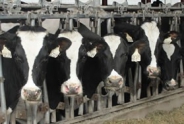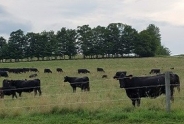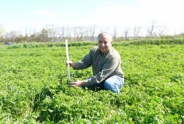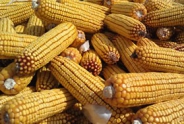5-12-2015 1st cutting update
Kevin Ganoe, Area Field Crop Specialist
Central New York Dairy and Field Crops
May 14, 2015
We have begun monitoring of 1st cutting for quality this year.
If you are not familiar with our procedures we use alfalfa height to predict Neutral Detergent Fiber (NDF) for alfalfa, alfalfa/grass mixed and grass stands. Alfalfa height has proven to be a reliable indicator of NDF values in the field. Here are numbers that are helpful when using alfalfa height as an indicator of NDF content:
In general we say 100% grass stands should be cut when nearby alfalfa is 14 inches tall to achieve the desired 50% NDF.
Begin cutting 50/50 mixed alfalfa and grass stands when nearby alfalfa is 22 inches tall for the desired 44% NDF.
Begin cutting 100% alfalfa stands when alfalfa is 28 inches tall for the desired 40% NDF.
The desired NDF for all grass fields is 50%, 50/50 mixed alfalfa and grass fields is 44%, and pure alfalfa stands is 40%. Predicted days to cut are based on daily NDF increases for grasses of 1% point, 50/50 mixed stands of .8% points and alfalfa of .5% point. Typically NDF increases about 0.8 to 1.2/day for grasses expecting the lower end of that range in cooler weather and the higher end in warm. Alfalfa NDF increases about 0.4 to 0.7/day again figuring the lower end of that range with cool temperatures and the higher in warm. Predictions are adjusted for the coming week’s weather and right now we are assuming normal growth.
In the attached tables locations around the region are listed where we have measured alfalfa height. You can use the location and elevation as a guide to conditions that may be similar to your own.
Every year is certainly different and 2015 is no exception. We did a dry run last week feeling that the fields were behind enough not to justify reporting. It appears we may just gone through one of the biggest jumps in alfalfa growth since we have started this monitoring. Since last week we had some alfalfa fields grow 9-11 inches where typically large jumps in the past have been in the 7-8 inch range. The warm temperatures really pushed alfalfa growth. However grass growth was atypical due to the dry conditions and is short by 2-4 inches as we now see some heading out. This is a reminder that grass may be behind in growth (yield) but it isn’t behind in maturity or fiber accumulation. So check your all grass or mostly grass fields there is a good chance they may need cut. Even mixed stands should be given some scrutiny!
As always use information in the attached table as a guide to know when to harvest by checking your fields! Next report May 19!
May 12, 2015 Quality Summary (pdf; 372KB)
Upcoming Events
Labor Roadshow IX
December 1, 2025
December 9 - December 10, 2025December 17 - December 18, 2025December 22, 2025
In-person and online events to keep NY's agricultural employers informed and prepared for today's labor challenges.
2026 Dairy Day
January 13, 2026 : Dairy Day - Hamilton
Hamilton, NY
Lunch included
January 14, 2026 : Dairy Day - Ballston Spa
Ballston Spa, NY
Lunch included
2026 Corn & Soybean Day
January 20, 2026 : Corn & Soybean Day - Hamilton
Hamilton, NY
Lunch included. 2.75 DEC Credits available
January 21, 2026 : Corn & Soybean Day - Ballston Spa
Ballston Spa, NY
Lunch included. 2.75 DEC Credits available
Announcements
Statewide Field Crop Pathology Needs Assessment Survey
Your input is wanted for identifying priorities!Please take a moment to fill out this brief and anonymous survey that will guide the Field Crops Pathology Research and Extension program.
Sign Up for Our Weekly E-Newsletter
We send out a bi-weekly e-newsletter that has announcements, upcoming programs, and opportunities for you! Registration is quick, easy, and free. Click here to sign up today!Farmers Can Join MeatSuite For Free!
MeatSuite.com is a free resource provided by Cornell University where NY meat farmers can create a farm profile and list their bulk (wholes, halves, quarters) and bundled (i.e. Grilling Bundle) meat products.Why should farmers join?
1. It's free and easy!
2. Connect with more local customers. In the past year the MeatSuite.com farm directory had 8,300 visits from New York consumers. Farm profiles get as many as 25 views per month from potential local customers. We also spotlight MeatSuite farms on social media and bring attention and purchases to farms through highlights and giveaways.
How do I join?
Farmers can visit https://www.meatsuite.com/farmers/ to create a free farm profile. You must list at least one product for your farm's profile to go live. You'll also have access to Cornell's free Meat Price Calculator, a helpful tool for pricing your meat to make a profit.
While you're on MeatSuite, check out the "Creating Consumer-Friendly Bulk Meats" publication on the log-in page. It has tips on how to create bulk meat products that are easier for first-time buyers to say "yes" to.
If you have any questions as you create your farm profile or products, we're here to help! Please email Matt LeRoux at mnl28@cornell.edu.




